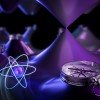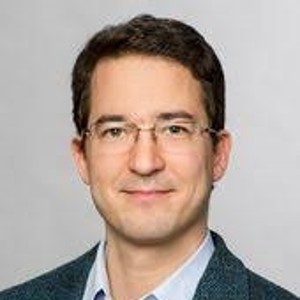
Classical simulation of non-Gaussian fermionic circuits
B. Dias, R. König
Quantum 8, 1-68 (2024).
We propose efficient algorithms for classically simulating fermionic linear optics operations applied to non-Gaussian initial states. By gadget constructions, this provides algorithms for fermionic linear optics with non-Gaussian operations. We argue that this problem is analogous to that of simulating Clifford circuits with non-stabilizer initial states: Algorithms for the latter problem immediately translate to the fermionic setting. Our construction is based on an extension of the covariance matrix formalism which permits to efficiently track relative phases in superpositions of Gaussian states. It yields simulation algorithms with polynomial complexity in the number of fermions, the desired accuracy, and certain quantities capturing the degree of non-Gaussianity of the initial state. We study one such quantity, the fermionic Gaussian extent, and show that it is multiplicative on tensor products when the so-called fermionic Gaussian fidelity is. We establish this property for the tensor product of two arbitrary pure states of four fermions with positive parity.

Twisted hybrid algorithms for combinatorial optimization
L. Caha, A. Kliesch, R. König
Quantum Science and Technology 7 (4), 45013 (2022).
Proposed hybrid algorithms encode a combinatorial cost function into a problem Hamiltonian and optimize its energy by varying over a set of states with low circuit complexity. Classical processing is typically only used for the choice of variational parameters following gradient descent. As a consequence, these approaches are limited by the descriptive power of the associated states. We argue that for certain combinatorial optimization problems, such algorithms can be hybridized further, thus harnessing the power of efficient non-local classical processing. Specifically, we consider combining a quantum variational ansatz with a greedy classical post-processing procedure for the MaxCut-problem on three-regular graphs. We show that the average cut-size produced by this method can be quantified in terms of the energy of a modified problem Hamiltonian. This motivates the consideration of an improved algorithm which variationally optimizes the energy of the modified Hamiltonian. We call this a twisted hybrid algorithm since the additional classical processing step is combined with a different choice of variational parameters. We exemplify the viability of this method using the quantum approximate optimization algorithm (QAOA), giving analytic lower bounds on the expected approximation ratios achieved by twisted QAOA. We observe that for levels p - 1, ..., 5, these lower bounds are comparable to the known lower bounds on QAOA at level p + 1 for high-girth graphs. This suggests that using twisted QAOA can reduce the circuit depth by 4 and the number of variational parameters by 2.

Hybrid quantum-classical algorithms for approximate graph coloring
S. Bravyi, A. Kliesch, R. König, E. Tang
Quantum 6, 678 (2022).
We show how to apply the recursive quantum approximate optimization algorithm (RQAOA) to MAX -k-CUT, the problem of finding an approximate vertex k-coloring of a graph. We compare this proposal to the best known classical and hybrid classical-quantum algorithms. First, we show that the standard (non-recursive) QAOA fails to solve this optimization problem for most regular bipartite graphs at any constant level p: the approximation ratio achieved by QAOA is hardly better than assigning colors to vertices at random. Second, we construct an efficient classical simulation algorithm which simulates level -1 QAOA and level -1 RQAOA for arbitrary graphs. In particular, these hybrid algorithms give rise to efficient classical algorithms, and no benefit arising from the use of quantum mechanics is to be expected. Nevertheless, they provide a suitable testbed for assessing the potential benefit of hybrid algorithm: We use the simulation algorithm to perform large-scale simulation of level -1 QAOA and RQAOA with up to 300 qutrits applied to ensembles of randomly generated 3-colorable constant-degree graphs. We find that level -1 RQAOA is surprisingly competitive: for the ensembles considered, its approximation ratios are often higher than those achieved by the best known generic classical algorithm based on rounding an SDP relaxation. This suggests the intriguing possibility that higher-level RQAOA may be a potentially useful algorithm for NISQ devices.

Oscillator-to-Oscillator Codes Do Not Have a Threshold
L. Hanggli, R. König
Ieee Transactions on Information Theory 68 (2), 1068-1084 (2022).
It is known that continuous variable quantum information cannot be protected against naturally occurring noise using Gaussian states and operations only. Noh et al. proposed bosonic oscillator-to-oscillator codes relying on non-Gaussian resource states as an alternative, and showed that these encodings can lead to a reduction of the effective error strength at the logical level as measured by the variance of the classical displacement noise channel. An oscillator-to-oscillator code embeds K logical bosonic modes (in an arbitrary state) into N physical modes by means of a Gaussian N-mode unitary and N-K auxiliary one-mode Gottesman-Kitaev-Preskill-states. Here we ask if - in analogy to qubit error-correcting codes - there are families of oscillator-to-oscillator codes with the following threshold property: They allow to convert physical displacement noise with variance below some threshold value to logical noise with variance upper bounded by any (arbitrary) constant. We find that this is not the case if encoding unitaries involving a constant amount of squeezing and maximum likelihood error decoding are used. We show a general lower bound on the logical error probability which is only a function of the amount of squeezing and independent of the number of modes. As a consequence, any physically implementable family of oscillator-to-oscillator codes combined with maximum likelihood error decoding does not admit a threshold.

Infinite-Dimensional Programmable Quantum Processors
M. Gschwendtner, A. Winter
Prx Quantum 2 (3), 30308 (2021).
"A universal programmable quantum processor uses ""program"" quantum states to apply an arbitrary quantum channel to an input state. We generalize the concept of a finite-dimensional programmable quantum processor to infinite dimension assuming an energy constraint on the input and output of the target quantum channels. By proving reductions to and from finite-dimensional processors, we obtain upper and lower bounds on the program dimension required to approximately implement energy-limited quantum channels. In particular, we consider the implementation of Gaussian channels. Due to their practical relevance, we investigate the resource requirements for gauge-covariant Gaussian channels. Additionally, we give upper and lower bounds on the program dimension of a processor implementing all Gaussian unitary channels. These lower bounds rely on a direct information-theoretic argument, based on the generalization from finite to infinite dimension of a certain ""replication lemma"" for unitaries."

On the modified logarithmic Sobolev inequality for the heat-bath dynamics for 1D systems
I. Bardet, A. Capel, A. Lucia, D. Perez-Garcia, C. Rouzé
Journal of Mathematical Physics 62 (6), 61901 (2021).
The mixing time of Markovian dissipative evolutions of open quantum many-body systems can be bounded using optimal constants of certain quantum functional inequalities, such as the modified logarithmic Sobolev constant. For classical spin systems, the positivity of such constants follows from a mixing condition for the Gibbs measure via quasi-factorization results for the entropy. Inspired by the classical case, we present a strategy to derive the positivity of the modified logarithmic Sobolev constant associated with the dynamics of certain quantum systems from some clustering conditions on the Gibbs state of a local, commuting Hamiltonian. In particular, we show that for the heat-bath dynamics of 1D systems, the modified logarithmic Sobolev constant is positive under the assumptions of a mixing condition on the Gibbs state and a strong quasi-factorization of the relative entropy.

Energy-Constrained Discrimination of Unitaries, Quantum Speed Limits, and a Gaussian Solovay-Kitaev Theorem
S. Becker, N. Datta, L. Lami, C. Rouzé
Physical Review Letters 126, 190504 (2021).
We investigate the energy-constrained (EC) diamond norm distance between unitary channels acting on possibly infinite-dimensional quantum systems, and establish a number of results. First, we prove that optimal EC discrimination between two unitary channels does not require the use of any entanglement. Extending a result by Acín, we also show that a finite number of parallel queries suffices to achieve zero error discrimination even in this EC setting. Second, we employ EC diamond norms to study a novel type of quantum speed limits, which apply to pairs of quantum dynamical semigroups. We expect these results to be relevant for benchmarking internal dynamics of quantum devices. Third, we establish a version of the Solovay-Kitaev theorem that applies to the group of Gaussian unitaries over a finite number of modes, with the approximation error being measured with respect to the EC diamond norm relative to the photon number Hamiltonian.

Convergence Rates for the Quantum Central Limit Theorem
S. Becker, N. Datta, L. Lami, C. Rouzé
Communications in Mathematical Physics 383 (1), 223-279 (2021).
Various quantum analogues of the central limit theorem, which is one of the cornerstones of probability theory, are known in the literature. One such analogue, due to Cushen and Hudson, is of particular relevance for quantum optics. It implies that the state in any single output arm of an n-splitter, which is fed with n copies of a centred state rho with finite second moments, converges to the Gaussian state with the same first and second moments as rho. Here we exploit the phase space formalism to carry out a refined analysis of the rate of convergence in this quantum central limit theorem. For instance, we prove that the convergence takes place at a rate O(n(-1/2)) in the Hilbert-Schmidt norm whenever the third moments of rho are finite. Trace norm or relative entropy bounds can be obtained by leveraging the energy boundedness of the state. Via analytical and numerical examples we show that our results are tight in many respects. An extension of our proof techniques to the non-i.i.d. setting is used to analyse a new model of a lossy optical fibre, where a given m-mode state enters a cascade of n beam splitters of equal transmissivities lambda(1/n) fed with an arbitrary (but fixed) environment state. Assuming that the latter has finite third moments, and ignoring unitaries, we show that the effective channel converges in diamond norm to a simple thermal attenuator, with a rate O(n(-1/2(m+1))). This allows us to establish bounds on the classical and quantum capacities of the cascade channel. Along the way, we derive several results that may be of independent interest. For example, we prove that any quantum characteristic function chi(rho) is uniformly bounded by some eta(rho) < 1 outside of any neighbourhood of the origin,. also, eta(rho) can be made to depend only on the energy of the state rho.

Obstacles to Variational Quantum Optimization from Symmetry Protection
S. Bravyi, A. Kliesch, R. König, E. Tang
Physical Review Letters 125 (26), 260505 (2020).
The quantum approximate optimization algorithm (QAOA) employs variational states generated by a parameterized quantum circuit to maximize the expected value of a Hamiltonian encoding a classical cost function. Whether or not the QAOA can outperform classical algorithms in some tasks is an actively debated question. Our work exposes fundamental limitations of the QAOA resulting from the symmetry and the locality of variational states. A surprising consequence of our results is that the classical Goemans-Williamson algorithm outperforms the QAOA for certain instances of MaxCut, at any constant level. To overcome these limitations, we propose a nonlocal version of the QAOA and give numerical evidence that it significantly outperforms the standard QAOA for frustrated Ising models.

Enhanced noise resilience of the surface-Gottesman-Kitaev-Preskill code via designed bias
L. Hanggli, M. Heinze, R. König
Physical Review A 102 (5), 52408 (2020).
We study the code obtained by concatenating the standard single-mode Gottesman-Kitaev-Preskill (GKP) code with the surface code. We show that the noise tolerance of this surface-GKP code with respect to (Gaussian) displacement errors improves when a single-mode squeezing unitary is applied to each mode, assuming that the identification of quadratures with logical Pauli operators is suitably modified. We observe noise-tolerance thresholds of up to sigma approximate to 0.58 shift-error standard deviation when the surface code is decoded without using GKP syndrome information. In contrast, prior results by K. Fukui, A. Tomita, A. Okamoto, and K. Fujii, High-Threshold Fault-Tolerant Quantum Computation with Analog Quantum Error Correction, Phys. Rev. X 8, 021054 (2018) and C. Vuillot, H. Asasi, Y. Wang, L. P. Pryadko, and B. M. Terhal, Quantum error correction with the toric Gottesman-Kitaev-Preskill code, Phys. Rev. A 99, 032344 (2019) report a threshold between sigma approximate to 0.54 and sigma approximate to 0.55 for the standard (toric, respectively) surface-GKP code. The modified surface-GKP code effectively renders the mode-level physical noise asymmetric, biasing the logical-level noise on the GKP qubits. The code can thus benefit from the resilience of the surface code against biased noise. We use the approximate maximum likelihood decoding algorithm of S. Bravyi, M. Suchara, and A. Vargo, Efficient algorithms for maximum likelihood decoding in the surface code, Phys. Rev. A 90, 032326 (2014) to obtain our threshold estimates. Throughout, we consider an idealized scenario where measurements are noiseless and GKP states are ideal. Our paper demonstrates that Gaussian encodings of individual modes can enhance concatenated codes.

Quantum advantage with noisy shallow circuits
S. Bravyi, D. Gosset, R. König, M. Tomamichel
Nature Physics 16 (10), 1040-+ (2020).
As increasingly sophisticated prototypes of quantum computers are being developed, a pressing challenge is to find computational problems that can be solved by an intermediate-scale quantum computer, but are beyond the capabilities of existing classical computers. Previous work in this direction has introduced computational problems that can be solved with certainty by quantum circuits of depth independent of the input size (so-called 'shallow' circuits) but cannot be solved with high probability by any shallow classical circuit. Here we show that such a separation in computational power persists even when the shallow quantum circuits are restricted to geometrically local gates in three dimensions and corrupted by noise. We also present a streamlined quantum algorithm that is shown to achieve a quantum advantage in a one-dimensional geometry. The latter may be amenable to experimental implementation with the current generation of quantum computers. Uncorrected noise prevents quantum computers from running deep algorithms and outperforming classical machines. A method is now reported that allows noisy shallow quantum algorithms to be used to solve classically hard problems.

Quantum Reverse Hypercontractivity: Its Tensorization and Application to Strong Converses
S. Beigi, N. Datta, C. Rouzé
Communications in Mathematical Physics 376, 753–794 (2020).
In this paper we develop the theory of quantum reverse hypercontractivity inequalities and show how they can be derived from log-Sobolev inequalities. Next we prove a generalization of the Stroock–Varopoulos inequality in the non-commutative setting which allows us to derive quantum hypercontractivity and reverse hypercontractivity inequalities solely from 2-log-Sobolev and 1-log-Sobolev inequalities respectively. We then prove some tensorization-type results providing us with tools to prove hypercontractivity and reverse hypercontractivity not only for certain quantum superoperators but also for their tensor powers. Finally as an application of these results, we generalize a recent technique for proving strong converse bounds in information theory via reverse hypercontractivity inequalities to the quantum setting. We prove strong converse bounds for the problems of quantum hypothesis testing and classical-quantum channel coding based on the quantum reverse hypercontractivity inequalities that we derive.

Continuum Limits of Homogeneous Binary Trees and the Thompson Group
A. Kliesch, R. König
Physical Review Letters 124 (1), 10601 (2020).
Tree tensor network descriptions of critical quantum spin chains are empirically known to reproduce correlation functions matching conformal field theory (CFT) predictions in the continuum limit. It is natural to seek a more complete correspondence, additionally incorporating dynamics. On the CFT side, this is determined by a representation of the diffeomorphism group of the circle. In a remarkable series of papers, Jones outlined a research program where the Thompson group T takes the role of the latter in the discrete setting, and representations of T are constructed from certain elements of a subfactor planar algebra. He also showed that, for a particular example of such a construction, this approach only yields-in the continuum limit-a representation which is highly discontinuous and hence unphysical. Here we show that the same issue arises generically when considering tree tensor networks: the set of coarse-graining maps yielding discontinuous representations has full measure in the set of all isometries. This extends Jones's nogo example to typical elements of the so-called tensor planar algebra. We also identify an easily verified necessary condition for a continuous limit to exist. This singles out a particular class of tree tensor networks. Our considerations apply to recent approaches for introducing dynamics in holographic codes.

Quantum advantage with noisy shallow circuits in 3D
S. Bravyi, R. König, D. Gosset, M. Tomamichel, Ieee
60th IEEE Annual Symposium on Foundations of Computer Science (FOCS) 995-999 (2019).
Prior work has shown that there exists a relation problem which can be solved with certainty by a constant-depth quantum circuit composed of geometrically local gates in two dimensions, but cannot be solved with high probability by any classical constant depth circuit composed of bounded fan-in gates. Here we provide two extensions of this result. Firstly, we show that a separation in computational power persists even when the constant-depth quantum circuit is restricted to geometrically local gates in one dimension. The corresponding quantum algorithm is the simplest we know of which achieves a quantum advantage of this type. Our second, main result, is that a separation persists even if the shallow quantum circuit is corrupted by noise. We construct a relation problem which can be solved with near certainty using a noisy constant-depth quantum circuit composed of geometrically local gates in three dimensions, provided the noise rate is below a certain constant threshold value. On the other hand, the problem cannot be solved with high probability by a noise-free classical circuit of constant depth. A key component of the proof is a quantum error-correcting code which admits constant-depth logical Clifford gates and single-shot logical state preparation. We show that the surface code meets these criteria.
